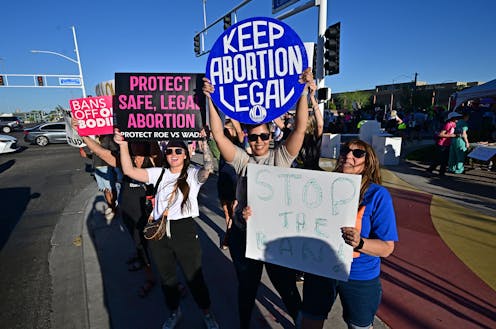Abortion restrictions harm mental health, with low-income women hardest hit
The uptick in anxiety, depression and other mental health issues happened after states enacted bans or restrictions on abortion.

People living in states that enacted tighter abortion restrictions in the wake of the Dobbs v. Jackson Women’s Health decision, which returned regulation of abortion access to state legislatures, are more likely to report elevated levels of mental distress. This is particularly true for people of lower socioeconomic means.
These are the key takeaways of our July 2024 paper published in Science Advances.
We mined two years’ worth of data from the National Household Pulse Survey and analyzed 21 survey waves, each with more than 60,000 respondents. We were able to trace how newly introduced gestational restrictions and abortion bans affected mental health outcomes such as anxiety, worry, disinterest and depression on a state-by-state basis. The increase in self-reported mental health issues amounts to an approximate 3% relative rise over the pre-Dobbs baseline of 18% to 26% – a troubling increase by any measure.
Why it matters
Two years after the Dobbs decision, the country is still coming to grips with its societal repercussions. Some states have tightened restrictions on abortion, while others have taken measures to preserve access, leading thousands of women to travel across state lines each month to obtain these services. As of July 2024, 21 states have passed abortion bans or enacted more restrictive gestational limits.
The decision to overturn a half-century of legal precedent has deeply affected women’s reproductive care and is altering the legal landscape that governs people’s decisions on whether and when to have children. These decisions are often stressful, as they involve navigating complex emotional, social and legal landscapes.
Accordingly, these sudden changes in access to abortion services may carry significant mental health consequences. Breaking down our results by demographic, we found consistent effects across birth-assigned gender, sexual orientation, age, marital status and race. However, we also found striking differences dependent on respondents’ income level and education.
Put plainly, abortion restrictions had a greater negative impact on the mental health of respondents of lesser economic means and the less educated. Those with more wealth and education, by contrast, were largely insulated.
As more states consider adopting restrictions of their own, with possible federal restrictions on abortion not off the table, it helps to have a more holistic sense of what that might mean for Americans.
In addition, our study underscores the need to think about women’s health across various subgroups of the population, especially as it pertains to sex assigned at birth and socioeconomic class.
What still isn’t known
We do not know exactly why socioeconomic class played such a pivotal role in our study, but we can speculate.
One possible explanation has to do with anticipatory stress about the financial burdens associated with carrying an unwanted pregnancy to term, or traveling out of state for an abortion. Financial concerns of this sort are likely more impactful on the mental health of Americans who are least able to bear these costs.
An alternative theory is that poorer women constitute a disproportionate percentage of the patient base receiving abortion care. According to a 2014 report from the Guttmacher Institute, an advocacy group, 75% of abortion patients qualified as low-income.
What other research is being done
Our work builds on findings from The Turnaway Study, which observed a marked decline in the short-term mental health of women who were denied an abortion because their pregnancy just exceeded the gestational limit. Our unique contribution resides in assessing the effect of abortion restrictions on mental health more broadly.
It’s important to realize that this paper is part of a growing body of work that shows the issues with mental health in the post-Dobbs era. Some studies have looked exclusively at women while others have begun to compare younger men and women. Whereas those works found effects were concentrated primarily among women of childbearing age, our results imply that a broader swath of the population has been affected.
The authors do not work for, consult, own shares in or receive funding from any company or organization that would benefit from this article, and have disclosed no relevant affiliations beyond their academic appointment.
Read These Next
What’s at stake in Trump’s executive order aiming to curb state-level AI regulation
In the absence of comprehensive federal AI regulation, states have stepped in. The Trump administration,…
Sleep problems and depression can be a vicious cycle, especially during pregnancy − here’s why it’s
Inadequate sleep can have negative downstream effects on everyday cognitive functioning and mental health,…
How a niche Catholic approach to infertility treatment became a new talking point for MAHA conservat
Mainstream medical organizations have criticized ‘restorative reproductive medicine,’ but some Catholics…





